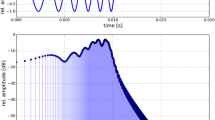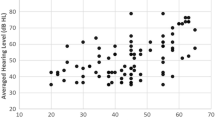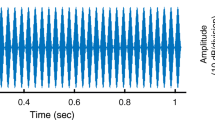Abstract
Purpose
To compare the effectiveness of chirp and tone burst stimuli in oVEMP and cVEMP testing for healthy adults
Methods
This study was conducted in 56 healthy volunteers (112 ears). Ocular and cervical VEMP (oVEMP, cVEMP) tests were performed for each participant using tone burst and chirp stimuli. VEMP response rates, latency of each peak (p1–n1, n1–p1), peak to peak amplitude (p1–n1 amplitude and n1–p1 amplitude), and rectified amplitudes were measured and compared between these two different stimuli.
Results
VEMP response rates with chirp stimuli are higher than the tone burst stimuli for both cVEMP and oVEMP tests (The difference was statistically significant for oVEMP, p = 0.001). Chirp stimuli have higher p1n1 amplitude and rectified amplitude and shorter p1and n1 latency then tone burst stimuli for cVEMP (p = 0.015, p = 0.007, p < 0.001, p < 0.001, respectively). Chirp stimuli also have higher n1p1 amplitude and shorter n1and p1 latency then tone burst stimuli for oVEMP (p = 0.006, p < 0.001, p < 0.001, respectively).
Conclusion
The present findings show that the chirp stimulus triggers earlier VEMP responses with higher amplitudes than the tone burst stimulus during cVEMP and oVEMP testing. VEMP response rate with chirp stimulus is also higher than the tone burst. Therefore chirp stimulus can be used in VEMP testing as effectively as, if not more than, tone burst stimulus in clinical practice.


Similar content being viewed by others
References
Colebatch JG, Halmagyi GM (1992) Vestibular evoked potentials in human neck muscles before and after unilateral vestibular deafferentation. Neurology 42(8):1635–1636
Murofushi T, Curthoys IS (1997) Physiological and anatomical study of click-sensitive primary vestibular afferents in the guinea pig. Acta Otolaryngol 117(1):66–72
Zhou G, Cox LC (2004) Vestibular evoked myogenic potentials: history and overview. Am J Audiol 13(2):135–143
Todd NP et al (2007) Ocular vestibular evoked myogenic potentials (OVEMPs) produced by air- and bone-conducted sound. Clin Neurophysiol 118(2):381–390
Rosengren SM, McAngus Todd NP, Colebatch JG (2005) Colebatch, vestibular-evoked extraocular potentials produced by stimulation with bone-conducted sound. Clin Neurophysiol 116(8):1938–1948
Curthoys IS et al (2011) The ocular vestibular-evoked myogenic potential to air-conducted sound; probable superior vestibular nerve origin. Clin Neurophysiol 122(3):611–616
Rosengren SM, Govender S, Colebatch JG (2011) Ocular and cervical vestibular evoked myogenic potentials produced by air- and bone-conducted stimuli: comparative properties and effects of age. Clin Neurophysiol 122(11):2282–2289
Kantner C et al (2014) The effects of rise/fall time and plateau time on ocular vestibular evoked myogenic potentials. Eur Arch Otorhinolaryngol 271(9):2401–2407
Welgampola MS, Colebatch JG (2005) Characteristics and clinical applications of vestibular-evoked myogenic potentials. Neurology 64(10):1682–1688
Wang BC et al (2014) Comparison of chirp versus click and tone pip stimulation for cervical vestibular evoked myogenic potentials. Eur Arch Otorhinolaryngol 271(12):3139–3146
Ozgur A et al (2015) Comparison of tone burst, click and chirp stimulation in vestibular evoked myogenic potential testing in healthy people. J Int Adv Otol 11(1):33–35
Akkuzu G, Akkuzu B, Ozluoglu LN (2006) Vestibular evoked myogenic potentials in benign paroxysmal positional vertigo and Meniere’s disease. Eur Arch Otorhinolaryngol 263(6):510–517
Streubel SO et al (2001) Vestibular-evoked myogenic potentials in the diagnosis of superior canal dehiscence syndrome. Acta Otolaryngol Suppl 545:41–49
Murofushi T, Matsuzaki M, Mizuno M (1998) Vestibular evoked myogenic potentials in patients with acoustic neuromas. Arch Otolaryngol Head Neck Surg 124(5):509–512
Khwaja Moinudeen AV (2020) Comparison of 500 Hz tonebursts and 500Hz octave chirps for cervical vestibular evoked potentials. Int J Sci Res Publ 10(3):332–335
Banu Bas KK, Er S, Ozdek A, Korkmaz MH (2020) Is chirp more effective than click and tone-burst during oVEMP test? Ann Med Res 27(3):819–824
Walther LE, Cebulla M (2016) Band limited chirp stimulation in vestibular evoked myogenic potentials. Eur Arch Otorhinolaryngol 273(10):2983–2991
Ochi K, Ohashi T, Nishino H (2001) Variance of vestibular-evoked myogenic potentials. Laryngoscope 111(3):522–527
Lee KJ et al (2008) The usefulness of rectified VEMP. Clin Exp Otorhinolaryngol 1(3):143–147
Kim KW et al (2013) Capacity of rectified vestibular evoked myogenic potential in correcting asymmetric muscle contraction power. Clin Exp Otorhinolaryngol 6(4):209–213
Colebatch JG, Halmagyi GM, Skuse NF (1994) Myogenic potentials generated by a click-evoked vestibulocollic reflex. J Neurol Neurosurg Psychiatry 57(2):190–197
Funding
No funding.
Author information
Authors and Affiliations
Corresponding author
Ethics declarations
Conflict of interest
The authors declare that they have no conflict of interest.
Additional information
Publisher's Note
Springer Nature remains neutral with regard to jurisdictional claims in published maps and institutional affiliations.
Rights and permissions
Springer Nature or its licensor (e.g. a society or other partner) holds exclusive rights to this article under a publishing agreement with the author(s) or other rightsholder(s); author self-archiving of the accepted manuscript version of this article is solely governed by the terms of such publishing agreement and applicable law.
About this article
Cite this article
Aydın, C., Önay, Ö., Tezcan, E.İ. et al. Comparison of cervical and ocular vestibular-evoked myogenic potential responses between tone burst versus chirp stimulation. Eur Arch Otorhinolaryngol 279, 2339–2343 (2022). https://doi.org/10.1007/s00405-021-06936-w
Received:
Accepted:
Published:
Issue Date:
DOI: https://doi.org/10.1007/s00405-021-06936-w




